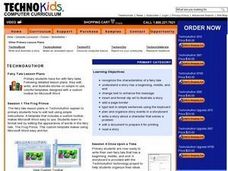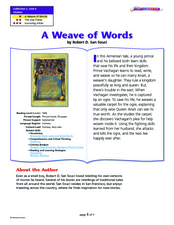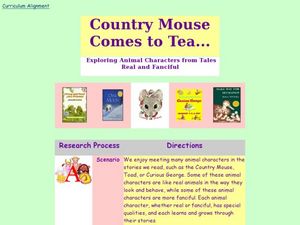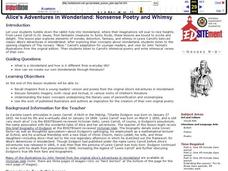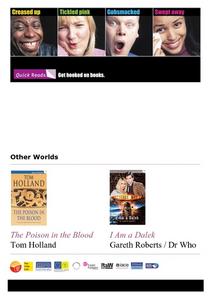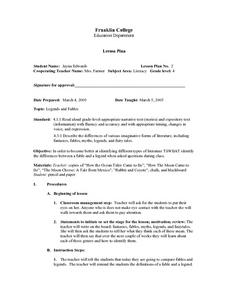Curated OER
Fact or Fantasy Writing
First graders see that some written text is for pleasure and enjoyment while some is for relaying information. They get to experience both types during the lesson. They brainstorm ideas for a story about a new kid in school to write about.
Curated OER
Fantasy, Fables, Myths, Legends & Fairy Tales
Students identify the differences between fantasies, fables, myths, legends and fairy tales. In groups, they create their own versions of the different genres. They practice identifying the examples, as well.
Curated OER
Fantasies and Myths
Fourth graders examine different types of literature, specifically myths and fantasy. They listen to "The Giving Tree", identify in which genre of literature it belongs, and view several myths on a website. At end of lesson, 4th...
Curated OER
Techno Author
Here is a great way to explore language arts by completing a computer activity with classmates. Youngsters read a fairy tale in class and analyze where the beginning, middle and end are. They create their own story using clip art and...
Curated OER
Writing a Tall Tale
Students study the various aspects of tall tales. They read various tall tales and discuss the characteristics and literature aspects of tall tales. Students write their own unique tall tales.
Curated OER
The Ancient Art of Shadow Puppet Plays
Shadow puppetry has an ancient past, it is also a great way to build oral expression and reading fluency. Young thespians research folk tales, compare and contrast reality and fantasy, then create and perform a shadow puppet play based...
Curated OER
A Weave of Woods
Focus on vocabulary, comprehension, and analysis while reading A Weave of Woods, a colorful picture book by Robert D. San Souci. Young learners use worksheets to preview, predict, practice paraphrasing, and make comparisons. The...
Curated OER
Writing Myths
Students read and write myths. In this world mythology instructional activity, students read and analyze myths from various cultures and then recognize their attributes as they write their own myths that explain natural phenomena.
Curated OER
Country Mouse Comes to Tea: Exploring Animal Characters from Tales Real and Fanciful
Students study animal characters. In this language arts lesson, students analyze animal characters from a variety of books and create a story using animal characters.
Curated OER
Fantasies and Myths
Fourth graders listen to the book, THE GIVING TREE and discuss what genre category they believe the story fits into and why. They read of of the myths on the website on the computers and then come back together as a group and discuss...
Curated OER
Nibble, Nibble, Little Mouse
Students complete activities to analyze points of view in different texts. In this point of view lesson, students read Hansel and Gretel and The Magic Circle and discuss the points of view. Students choose a character from the story and...
Curated OER
Alice's Adventures in Wonderland: Nonsense Poetry and Whimsy
Primary learners are introduced to Lewis Carroll's whimsical poetry. They read "The Nursery Alice" Carroll's adaptation for younger readers, view story illustrations, listen to poetry and write whimsical verses of their own about food.
Curated OER
Lesson Plan for The Little Red Hen
Cultivate young performers while teaching them about helping one another with this interactive storytelling lesson. Elementary schoolers read or listen to the story The Little Red Hen by Mike Lockett and then act out the story while...
Curated OER
Knights and Castles and Kings Galore
Fifth graders create a fairy tale story with emphasis on castles. After reading various texts featuring castles and their residents, 5th graders complete a book report project. The book report serves as a springboard to the writing...
Curated OER
Tall Tales Folded Envelope Book
Learners create a book using art, problem solving and language skills. They illustrate and write a tall tale. They sculpt a character from their tall tale.
Curated OER
Cinderella: A Story Found in Many Cultures
First graders explore, discuss and examine fairy-tale and make-believe stories. They assess two different types of Cinderella stories to surface a broader look at cultural diversity. Students construct a Venn Diagram or a chart of the...
Curated OER
Citizens for Responsible Change
Third graders write a petition to a school figure, get signatures from other students, share the petition with the appropriate authority, and then work as leaders to carry out the group's solution.
Curated OER
Lord of the Rings: The Quest is Achieved
Students analyze what makes a hero in The Lord of the Rings, Book Six. They discuss the characters and the aspects of their behaviors that make them heroes and write essays regarding the climax and heroic gestures of a character. After...
Curated OER
Coyote and Anansi
Students explore the structure of folktales. In this coyote and Anansi instructional activity, students discuss the attributes of folktales as they read versions of tales featuring coyote and Anansi. Students collaborate to write and...
Curated OER
Reporting Live From...
Young scholars examine the many disasters in West Virginia. In this US history lesson plan, students write about and give an oral presentation of one of the disasters as if they were reporters.
Curated OER
Hank Williams: My Inspiration
Students research information about Hank Williams using the internet. Using the lyrics from his songs, they interpret the poetry used. They work together and individually to write their own poems and interpret them.
Curated OER
Cloudy With a Chance of Meatballs
Fourth graders participate in a play to work on seeing events from a different perspective. Some of them are reporters, some cameramen and women, and others are interviewed. They put themselves in the shoes of the people in the book...
Curated OER
Other Worlds
Students explore the variety of 'other worlds' in fiction and their uses in reflecting our own. They explore the role of myth and
legend as the basis for modern story telling. Book extracts are provide for classroom use.
Curated OER
Legends and Fables
Fourth graders identify and discuss the differences between legends and fables. They define fable and legend, then as a class take turns reading our books. Students select two of the stories, and complete a Venn diagram, comparing one...



